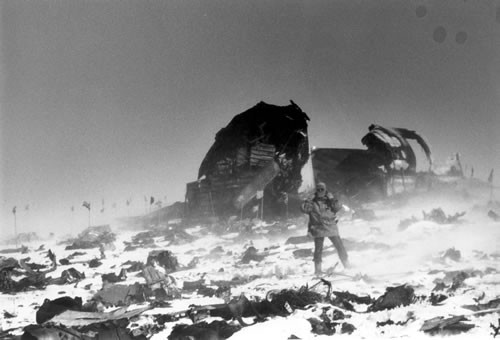
Recovery work among the debris of Air New Zealand Flight TE901 on Mt Erebus continued even in terrible weather conditions. The original caption of this photograph reads: ‘Hugh Logan below main fuselage. Strong ground blizzard blowing through wreckage’.
No survivors
Final confirmation that there were no survivors came on the morning after the crash. At approximately 9.45 a.m. (NZST)* on 29 November 1979 three New Zealand mountaineers, Keith Woodford, Hugh Logan and Daryl Thompson, were lowered onto the crash site by a US Navy UH-1N helicopter. And at approximately 10.30 a.m. (NZST) it was reported back to Mac Centre, the US Navy's air traffic control centre at McMurdo Station, that they had signalled that there were no survivors.
Special edition:
On the afternoon of 29 November the Otago Daily Times, which had not altered the headline in its morning edition to reflect the discovery of the wreckage, issued a free special edition. The first and second press runs, 26,000 copies, were all snapped up.
Mac Centre transmitted this news to the Operation Deep Freeze base in Christchurch and at 12.23 p.m. (NZDT) the base's Press Liaison Officer, Mike Hatcher, issued a brief statement confirming that 'everybody that was on that aircraft has died'. Radio bulletins and evening editions of newspapers reported this news and further details of the crash site subsequently provided by the mountaineers.
Grief crisis centre
In the immediate aftermath of the Erebus disaster a grief crisis team was set up at Carrington Hospital, Auckland, to provide counselling to the families of victims. The team's coordinator, Carrington psychologist Audrey Muir, encouraged the bereaved to talk about their feelings, noting that this would hasten ‘the passing of acute grief’. The centre closed after approximately a week but continued to take calls from anyone in need.
*On the day of the Erebus disaster there was a one-hour time difference between New Zealand and McMurdo Station. McMurdo Station was operating under New Zealand Standard Time (NZST) while New Zealand was operating under daylight saving or New Zealand Daylight Time (NZDT). Scott Base and McMurdo Station did not begin observing daylight saving until 1992/93.
Next page: The first party



Community contributions